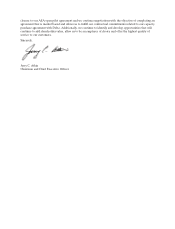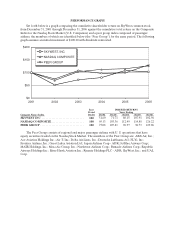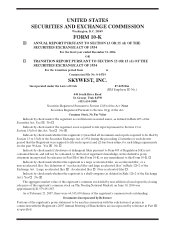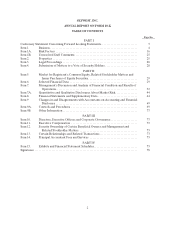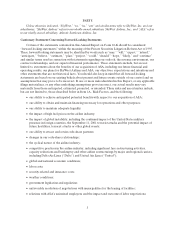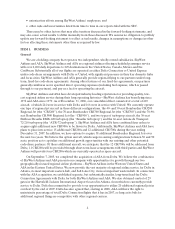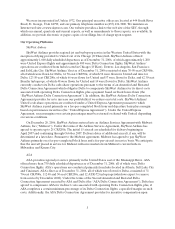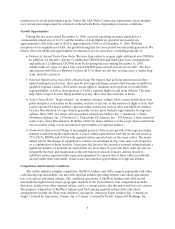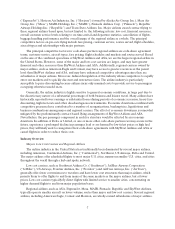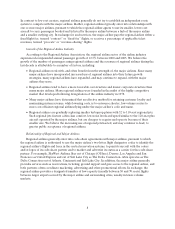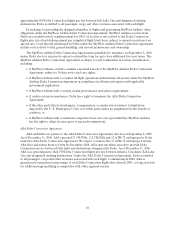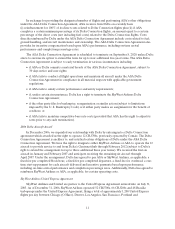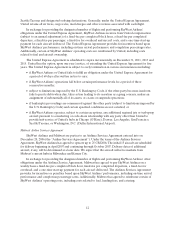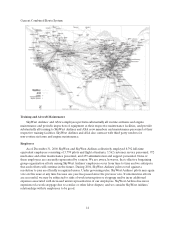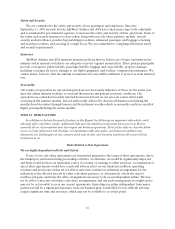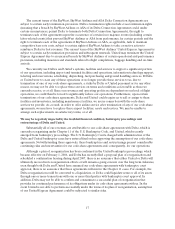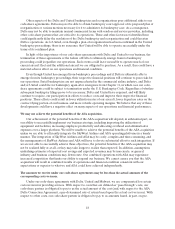SkyWest Airlines 2006 Annual Report Download - page 14
Download and view the complete annual report
Please find page 14 of the 2006 SkyWest Airlines annual report below. You can navigate through the pages in the report by either clicking on the pages listed below, or by using the keyword search tool below to find specific information within the annual report.8
In contrast to low cost carriers, regional airlines generally do not try to establish an independent route
system to compete with themajor airlines. Rather, regional airlines typically enter into relationships with
oneor moremajor airlines, pursuant to which the regional airline agrees to use its smaller,lower-cost
aircraft to carry passengers booked andticketed by the major airlinebetween ahub of themajor airline
and a smalleroutlying city. In exchange for such services, themajor airline pays theregional airline either a
fixed flightfee, termed “contract” or “fixed-fee” flights, or receives a percentage of applicable ticket
revenues,termed “pro-rate”or “revenue-sharing” flights.
Growth of the RegionalAirline Industry
According to the Regional Airline Association, theregional airline sector of the airline industry
experienced compounded annualpassenger growth of 12.3%between 2000 and 2005. We believe the
growth of the number of passengers using regionalairlines andthe revenues of regional airlines during the
last decade is attributable to a number of factors, including:
•Regional airlines work with, and often benefit from the strength of, themajor airlines. Sincemany
major airlines have incorporated increased use of regionalairlines intotheir future growth
strategies, many regional airlines have expanded, andmay continue to expand,with the major
airlines they serve.
•Regional airlines tend to have a more favorable cost structure and leaner corporate structurethan
many major airlines.Many regionalairlines were founded in the midst of the highly competitive
market that developed followingderegulation of theairline industry in 1978.
•Many major airlines have determined that an effective method for retaining customer loyalty and
maximizing system revenue, while lowering costs, is to outsource shorter,low-volume routes to
more cost-efficient regionalairlines flying under the majorairline’s code and name.
•Regional airlines are gradually replacing smaller turboprop planes with 32 to 110-seat regional jets.
Such regional jets feature cabin class comfort, low noise levels and speed similar to the120-seat plus
aircraft operated by themajor airlines, but arecheaper to acquire and operate because of their
smaller size.We believe the increasing useofregional jets hasled, andmay continue to lead, to
greaterpublic acceptance of regional airlines.
Relationship of Regionaland Major Airlines
Regional airlines generallyenterinto code-share agreements with major airlines, pursuant to which
the regionalairline is authorized to use the major airline’s two-letter flight designator codes to identify the
regional airline’s flights and fares in the central reservation systems, to paint its aircraft with the colors
and/or logos of its code-share partner and to market andadvertiseits status as acarrier for the code-share
partner. For example, SkyWest Airlines flies out of Chicago(O’Hare), Denver, Los Angeles and San
Francisco as United Expressand out of Salt Lake City as The Delta Connection. ASA operates as The
Delta Connection out of Atlanta, Cincinnati and Salt LakeCity. In addition, the majorairline generally
provides services such as reservations, ticketing, ground support andgate access to the regional airline,and
both partners often coordinate marketing, advertisingand other promotional efforts. In exchange, the
regional airline provides a designated number of low-capacity (usually between 30 and 70 seats) flights
between largerairports served by themajor airline and surroundingcities, usually in lower-volume
markets.


